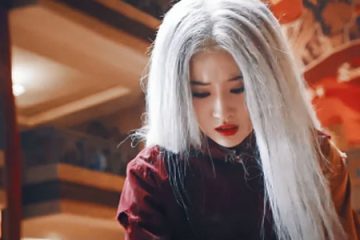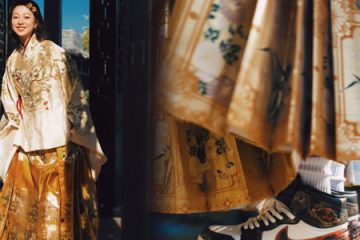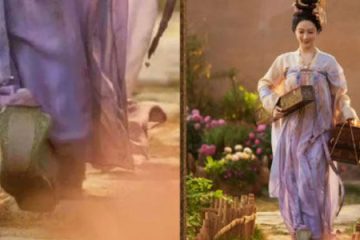Why Do All Characters in Historical Dramas Have V-Shaped Faces Now?

Recently, the Tang Dynasty styling in The Litchi Road has been a hit among viewers. However, many netizens have expressed their frustration with the overly sharp, V-shaped faces of the actresses, commenting: “They’re so slim, they can’t even carry the grandeur of ancient China!” The combination of extreme face-slimming makeup and heavy traditional hanfu styling often looks jarring and unnatural.
Ⅰ. The Trend of “Contoured Beauty”
In recent years, heavy contouring and exaggerated features like sharp jawlines and oversized eyes have become the standard—especially in film, TV, and even gaming. But when every actress has the same face shape and similar makeup, it becomes hard to tell them apart. Worse, it strips away the elegance and uniqueness of classical aesthetics.
Take this comparison photo, for example. The left shows a traditional makeup look, while the right shows a modern take. Sure, the modern one may seem more “camera-friendly,” but the traditional version carries far more character and charm.

Empress Wu Zetian admired, reportedly saying, “She resembles me.” This kind of face—broad, rounded, with a strong jawline—was seen as a symbol of good fortune and classical beauty.

Back then, the ideal face shape was more square or round, not the sharp V-shaped face that’s popular today. In fact, at the height of Tang aesthetics, some women even styled their hairlines into angular shapes to emphasize a broader silhouette. While modern viewers might see this as a “pancake face,” it’s important to remember that the Tang standard celebrated natural fullness and strength—not the overly thin or contoured look that’s now common in media.

Ⅱ. The Beauty of Square – Rounded Faces
In traditional Chinese aesthetics, the square – rounded faces have long been seen as visually pleasing and harmonious. During the Tang Dynasty, fuller facial features symbolized health, confidence, and prosperity. After all, only a free and natural appearance could truly reflect the grandeur and vitality of a flourishing era.
In ancient artwork, especially depictions of noblewomen, we often see full, rounded faces with gentle expressions—paired with “three-white” makeup that served a similar function to today’s contouring. But instead of harsh lines and angles, these women appeared confident and serene.

Take the murals of Dunhuang, for example: the female donor figures vary in height and size, yet they all radiate beauty in their own way. Even by modern standards, many of these features—double chins, soft jawlines, fuller noses, and curved arms—carry their own kind of grace. They may not match today’s Western ideals of beauty (like high cheekbones or dramatic brows), but their elegance lies in their authenticity and quiet strength.

Back then, even though beauty standards often flowed from the elite down, most people still maintained healthy, natural body types—thin, V-shaped faces were rare. As a result, rounder, fuller faces naturally came to represent the ideal of beauty.
There’s nothing inherently unattractive about square-rounded faces. The problem is that people today chase trends so blindly that they’ve lost confidence in traditional aesthetics. Interestingly, this classic “Eastern beauty” is actually appreciated as high fashion in the West—many top Western celebrities have similar facial features, which echoes a refined version of what we call “Oriental beauty.”

Ⅲ. The Disappearance of Fullness
In modern costume dramas, the absence of fuller facial features often clashes with historical styling. No matter how loudly a production claims to “faithfully recreate historical looks,” the hanfu hairstyles and makeup rarely suit the contemporary faces they’re applied to. Today’s slim, V-shaped faces struggle to support the visual weight of elaborate traditional styling—like oversized buns or tall hairpieces—which can lead to an unbalanced, top-heavy look.
This mismatch is made worse by the mix of modern and ancient aesthetics. Some stylists even add heavy smoky makeup, oversized lashes, ultra-defined chins, small noses, glossy lipstick, exaggerated curves, tight-fitting dresses, and other modern beauty elements. While these features are often seen as “refined,” they also strip away uniqueness—resulting in a crowd of overly similar faces that feel more artificial than elegant.

Influenced by modern consumerism and media aesthetics, both men and women are experiencing growing appearance anxiety. Men are becoming more delicate to appeal to female fans, while women chase ever-smaller faces—resorting to cosmetic procedures, photo editing, or extreme dieting. This trend strays far from the healthy beauty ideals once valued in Chinese culture. No wonder older directors prefer actresses with a bit more fullness—it simply looks more authentic on screen.

Summary
With a growing appreciation for diverse beauty, more viewers are calling for stars to embrace their individuality. If sharp chins become the only standard, we lose what makes each person unique. After all, every woman is beautiful in her own way. If you agree, don’t forget to share your comment!



0 Comments